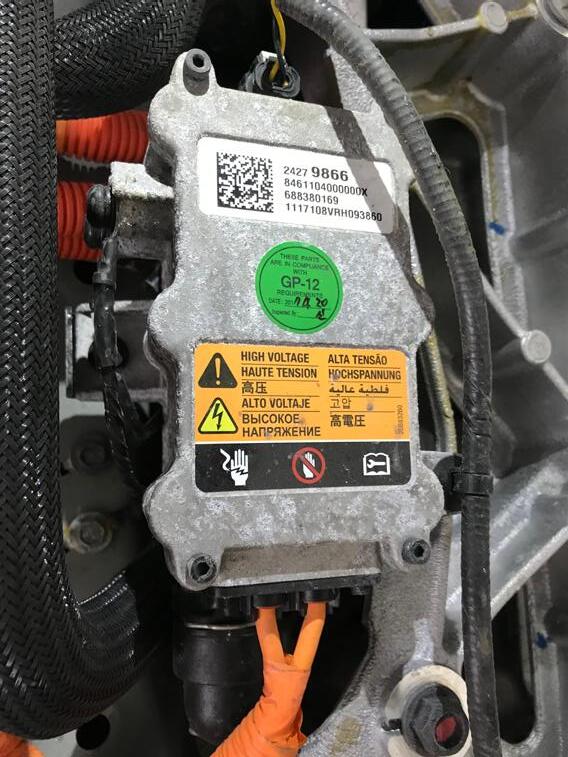
7 minute read
April 2023 Hybrid & Electric Vehicle Corner
by NACATNews
By Curt Ward, Professor at Joliet Junior College
Servicing the Air Conditioning System on a Hybrid or Electric Vehicle
During the spring semester many instructors are teaching their automotive air conditioning course. As the number of hybrid and electric vehicles on the road increases so do the methods of heating and cooling the passenger compartment as well as the battery and high-voltage electronics. In this article we will explore the basic service of these systems.
Let’s begin with high-voltage safety. Modern hybrid and electric vehicles use a high-voltage electric compressor to circulate the refrigerant through the system. Before servicing the compressor, it is important to know how to safely depower the high-volage system. Typically, the process includes disconnecting the 12-volt battery and removing the high-voltage disconnect. It is important wear the proper person protective equipment when removing the high voltage disconnect. This includes properly fitted class “0” gloves rated at 1000 volts with clean leather protective gloves over the top.
Speaking of compressors, it is important to remember the refrigerant oil used in hybrid and electric vehicle is different than the refrigerant oil used in a conventional vehicle. Currently, hybrid and electric vehicles, regardless of whether they use R134A or R1234YF refrigerant, use a POE (polyol ester) refrigerant oil. The POE oil is very hydroscopic and has very specific storage and use requirements. Refer to the specific service instructions to ensure moisture is not unintentionally added to the system. Failure to use the correct oil may cause the deterioration of the insulation of the windings and may cause the compressor to become electrically conductive. Most OE manufacturers are specifying separate refrigerant recovery systems for vehicles that use POE so there is no change of cross-contamination with a system that uses PAG (polyalkylene glycol) oil.
Many of us use dye in the refrigerant system to locate those difficult to find leaks. Make sure to use a dye that is compatible with a high-voltage compressor system. The wrong dye can also lead to a loss of isolation fault and shut the system down.
With the introduction of R134A and later R1234YF, combined with the efficiencies of an electric air conditioning compressor, the normal charge level of refrigerant has dropped significantly in most systems. Most systems today barely have one pound of refrigerant when properly charged. The efficiency of these systems drops dramatically when the system is undercharged or overcharged. In most diagnostic scenarios, the only way to ensure the system has a proper charge is to recover the refrigerant and then recharge to the specified level. When evacuating the system, notice that many systems with an electric compressor are specifying a minimum of 45 minutes of evacuation time. This will help ensure all the moisture has been removed from the system. With the varied heat and humidity loads, pressure readings on a set of manifold gauges are not an accurate enough measurement of the charge level.
Most hybrid electric vehicle batteries are located within the passenger compartment or trunk area. The batteries are heated and cooled with the same air that is used to heat and cool the passenger compartment. To maintain proper airflow around and through the battery there may be specific maintenance that needs to be performed. Several manufactures have cabin filters in the air intake system to prevent dirt, pet hair, and other debris from entering the battery cooling system (See Figure 1 – Filter). These filters require replacement on a regular service interval. Other manufactures suggest cleaning the air intake ductwork and cooling fan to remove dirt and debris to improve battery cooling. Proper heating and cooling of these batteries will help to ensure they reach their maximum service life.

Figure 1: Filter
The high-voltage battery on many electric vehicles is heated and cooled with a coolant loop. The example I will use for this article is the Chevrolet Bolt. When the battery temperature is below the specified ideal temperature a high-voltage battery coolant heater is used to warm the coolant. The coolant heater is a 2000-watt heating element immersed in coolant (See Figure 2 –Heater). The battery coolant loop uses an electric pump to circulate the coolant but does not have a radiator. If the battery is above the desired operating temperature, the heat in the coolant is removed by the battery chiller. The battery chiller is a mini evaporator with a separate thermal expansion valve (TXV) that is part of the high-voltage refrigerant system. The system operates both when the vehicle is be driven as well as when the battery is being charged. A low refrigerant charge will result in poor passenger compartment cooling and an unacceptable battery recharge rate, particularly when using a DC fast charger. The additional coolant loops require regular service using a premix of Dexcool and deionized water.

Figure 2: Heater
Lastly, I want to reference the increased use of heat pump systems in electric vehicles. A heat pump is basically a reversible air conditioning system that provide both cabin heating and cabin cooling. A heat pump system is more efficient than PTC or electric heating and allows the manufacturer to maximize the vehicle range, particularly in the winter (See Figure 3 –Heat Pump). Some heat pump systems capture energy by recycling waste heat from power electronic modules, drive motors, on-board chargers, the battery pack, and inverters to warm the passenger compartment. These systems have the same requirement for the correct airflow and refrigerant charge as a conventional climate control system.

Figure 3: Heat Pump
To close, I want to reference a vehicle I recently worked on. The vehicle was a third generation Toyota Prius. The customer concern was that the air conditioning was not blowing cold and that there was a noise in the engine compartment. When the air conditioning was turned on, it sounded like there was gravel in the compressor. Diagnosis revealed that the high side pressure was low and the low side pressure was high. Additionally, there was evidence that the pressure relief valve had allowed refrigerant to escape from the system and then resealed. Further diagnosis did not reveal any reason why there would have been a loss of refrigerant at the pressure relief valve. Additional conversations with the customer revealed they had tried to fix the lack of cooling by adding “cans” of refrigerant from the local parts store. It was determined that the electric motor within the compressor was strong enough to destroy the scroll as a result of an overcharge condition. Just because it is high-voltage does not mean a customer may not try to fix it first.
I will finish this article with the same offer I make after each of my presentations. If you are interested in getting started and want more information, please feel free to reach out. I am more than willing to sit down in-person or online and share my experiences. Are you looking for a classroom textbook? Reach out to Pearson and ask for a review copy of the all-new Electric and Hybrid Electric Vehicle text that Jim Halderman and I co-authored. It is a comprehensive text covering all the latest information on the subject.



